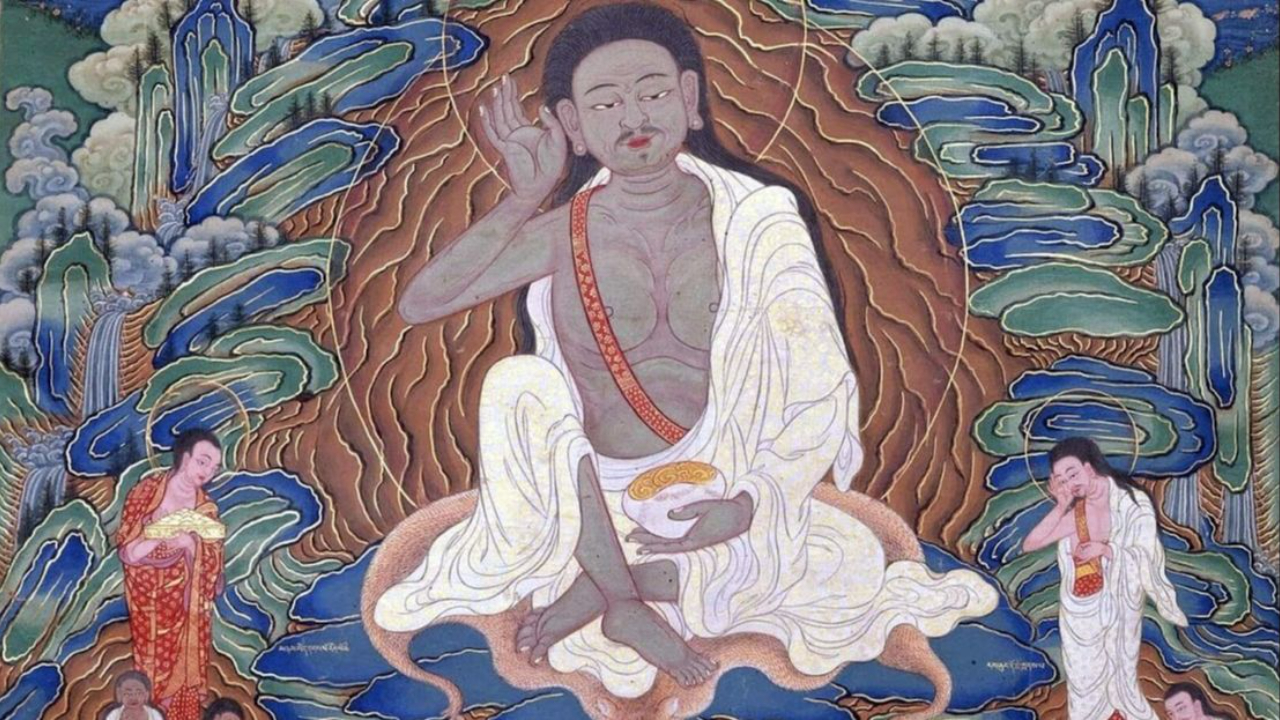What is Kali Yuga? The Four Hindu Ages Explained
Oct 10, 2025
Kali Yuga is the fourth and final age in Hindu cosmology, often called the Dark Age. It is the period when dharma, which represents truth, right living, and proper behavior, stands on its weakest leg. Where earlier ages were marked by clarity and disciplined spiritual practices, Kali Yuga is marked by moral decline and superficial attraction to external symbols.
We are in Kali Yuga now. The present age fits the classic signs of Kali, where human society prizes power over wisdom and inner peace is hard to hold without deliberate practice and guidance from others. The mirrored Yuga cycle descends to its nadir in Kali Yuga, passes through a brief transitional cusp, and then rises again with the ascending Kali Yuga, continuing upward through ascending Dvapara and Treta and culminating in ascending Satya Yuga.
Bees, Light, Shadow, and the Kali Yuga

One of the delightful memories from my childhood is this one:
I am 3 years of age and it is a warm and sunny morning in the back garden of my home. My mother is hanging wet laundry. The laundry waves in the morning breeze as the gentle sun gives rise to a delicious sense of pleasure and anticipation of discovery. Butterflies dance with flowers and bees hum in their busy work of gathering nectar. The garden is enchanted as I gleefully chase the colourful butterflies, trying to fly as they do.
My mother lovingly explains to me that because the butterflies gather pollen, the trees will later bring forth fruits. And by gathering nectar from flowers, bees create honey, which then becomes our delight. As she explains nature’s miracles to me, my ecstasy escalates, expanding into the infinite blue sky. I hop, skip and jump through the garden and then lay down on the ground, gazing at fluffy white clouds. My ecstasy transforms into gratitude for being alive, merging with this beauty.
Fast forward to March, 2016. I am looking through my inbox of emails and one jumps out at me:
“A shocking new United Nations study finds that bees, butterflies, and other pollinators are in even greater danger than we previously thought, and may even be at risk of extinction.
Conducted by a top team of 70 U.N. scientists, the report is the first-ever global study on the health of bees and other pollinators. And the results are much, much worse than many expected. Meanwhile, Bayer, one of the world’s biggest producers of bee-killing pesticides, is SUING the European Commission to lift its ban on the pesticides that are driving bees toward extinction. Without bees and other pollinators, the world will face a global food crisis.
Almost 90 percent of all flowering plants rely on pollinators – including 75 percent of the world’s food crops. In other words, when bees die, people starve. Of course, we’ve known for a long time that bee populations are in decline. But this study shows that the threat of global extinction has risen to a whole new level.
It’s perhaps the biggest wake-up call we’ve gotten yet — and that’s why we’re demanding that the world’s biggest producers of bee-killing pesticides take these deadly products off the market.” I put my head in my hands and feel grief. If killing bees and butterflies for the sake of more pesticide sales is what humanity has fallen to, I am ashamed of calling myself human! How is it possible that we have arrived at this point of destroying the incredible and abundant gifts of Gaia upon which our survival depends?
I need an explanation, a mystical insight to explain this situation with the human condition. It appears the collective human shadow is so great that we now identify only with darkness and unconsciousness forgetting the light. How did this happen and what is the cure? Knowing that Mother India gave birth to great mystics with far seeing abilities, I looked up clairvoyant predictions from sages who lived more than 5000 years ago. Ancient spiritual traditions from India and other places in the world speak about cycles of creation and destruction, the old collapsing and a new cycle of life emerging from the ashes, like the proverbial phoenix. These cycles have been mapped by far seeing sages, for our benefit.
What Is Kali Yuga?
In Hindu cosmology, time moves in great cyclical waves through four ages (yuga): Satya (Krita) → Treta → Dvapara → Kali. Kali Yuga marks the nadir, the lowest point of spiritual decline, when dharma stands on its weakest leg. Yet this is also the turning point. After the descending Kali concludes, an ascending Kali Yuga begins, symbolizing humanity’s gradual climb out of darkness and into renewed awareness before the cycle continues toward a new Satya Yuga.
Kali does not refer to the goddess Kali. It comes from the term for strife, quarrel, hypocrisy, and discord. In earlier yugas, human society could rely on instinctive virtue (Satya), then duty and sacrifice (Treta; Lord Rama and Lord Hanuman), then temple worship and epic teaching (Dvapara; Lord Krishna and the Gītā). By Kali, those supports thin. Spiritual practices survive, but institutions and leaders often tilt toward political power and religion that helps people gain political power rather than cultivate truth.
Traditional reckoning places the Kali Yuga start on the very day Śrī (Lord) Krishna departed the earth, closing Dwapara Yuga and opening Kali.
Kali Yuga Prophecies
Our present predicament in the world has been prophesied by countless Sages. About this Kali Yuga, The Linga Purana (as quoted in ‘While the Gods Play: Predictions on the Cycles of History and the Destiny of Mankind’ by Alain Danielou, published by Inner Traditions) says pointedly:
"Rulers will confiscate Property and use it badly. Thieves will become Kings and Kings will be the thieves. They will cease to protect the people. Base men who have gained a certain amount of learning without having the virtues for its proper use, will be esteemed as Sages. There will be many displaced persons, wandering from one country to another. Predatory animals will become more violent.
Foetuses will be killed in the womb of their mother. People will prefer to choose false ideas. No one will be able to trust anyone else. People will be envious. There will be many children born whose life expectancy is no more than 16 years.
Young girls will trade in their virginity. People suffering from hunger and fear will take refuge in underground shelters. The God of clouds will be inconsistent in the distribution of rains. Shopkeepers will run dishonest businesses. There will be many beggars and unemployed people. Everyone will use hard and vulgar language.
Men will devote themselves to earning money; the richest will hold power. The state leaders will no longer protect the people but will appropriate more wealth through taxation. Water will be lacking. Pre-cooked food will be readily available."
A Sage named Vedavyasa who lived 5000 years ago also speaks about the Kali Yuga:
“Cities will be dominated by thieves, the Vedas will be contaminated by speculative interpretations of atheists, political leaders will virtually consume the citizens, and the so-called priests and intellectuals will be devotees of their bellies and genitals.”
In Wikipedia, there is a quote from the Mahabharata, given by a sage named Markandeya about human relations during the Kali Yuga.
“Avarice and wrath will be common. Humans will openly display animosity towards each other. Ignorance of dharma will occur. People will have thoughts of murder with no justification and will see nothing wrong in that. Lust will be viewed as socially acceptable and sexual intercourse will be seen as the central requirement of life.
Sin will increase exponentially, whilst virtue will fade and cease to flourish. People will take vows and break them soon after. People will become addicted to intoxicating drinks and drugs. Gurus will no longer be respected and their students will attempt to injure them. Their teachings will be insulted, and followers of Kama (sexual desire) will wrest control of the mind from all human beings. Brahmans will not be learned or honoured, Kshatriyas will not be brave, Vaishyas will not be just in their dealings.”
How we weather the storm of the Kali Yuga all depends on how much we can raise our consciousness. The chaos cycle we are now in is certainly destructive, but it is also creative. I have heard Osho say: “Out of chaos, great stars are born.”
When we are in a chaos cycle, old patterns are shaken up and it is an opportunity for creative people to manifest a new vision for the world.
Why the Dates Are So Different In Various Systems
Different traditions give very different dates for the yugas because they rely on different calculations and reference points. Some systems count the yugas in vast spans of hundreds of thousands of years, while others compress them into much shorter cycles tied to astronomical phenomena such as the precession of the equinoxes. Some traditions treat the numbers in the Purāṇas as literal, while others interpret them symbolically and scale them to match human history.
In the classical Purāṇic system, which is the one most often quoted in texts like the Vishnu Purāṇa or Mahābhārata, the four yugas together span 4.32 million years. Kali Yuga alone is said to last 432,000 years and is anchored to a historical-mythic moment: the departure of Lord Krishna in 3102 BCE. According to this reckoning, we are only about 5,000 years into Kali Yuga, with hundreds of thousands of years still to go.
A very different model was introduced by Sri Yukteswar in his 1894 text The Holy Science. He argued that the yugas correspond to a 24,000-year astronomical cycle, with each yuga containing both a descending and an ascending half. In this system, Kali Yuga ended centuries ago, and we are already in an ascending Dvāpara Yuga, which is why technological and scientific progress has accelerated so rapidly in modern times.
There is also a modern reconstruction of the Yuga cycle, proposed by researchers such as Bibhu Dev Misra and popularized by writers like Graham Hancock. The interpretation that most resonated with me is the one outlined by Alain Daniélou in While the Gods Play. This approach condenses the vast Purāṇic timelines into thousands rather than hundreds of thousands of years, aligning the Yugas with observable astronomical cycles (such as the precession of the equinoxes) and known shifts in human civilization.
In this model, the descending Kali Yuga reached its lowest point in the early centuries of the Common Era, marking the depth of spiritual and cultural decline. The cycle then began its ascending arc, with consciousness slowly recovering over the last two millennia. Kali Yuga, in its ascending phase, is said to end around 2025, after which a transitional sandhi of approximately 300 years will bridge the shift into ascending Dvapara Yuga, when human awareness and technological progress begin to harmonize with spiritual insight once again.
Descending and Ascending Kali Yuga
Classical Hindu texts such as the Vishnu Purāṇa and Mahābhārata describe the yugas as a single descending cycle, where humanity gradually falls from Satya Yuga (the golden age) into Kali Yuga (the dark age), after which the cycle renews.
Modern interpretations (such as those taught by Sri Yukteswar in The Holy Science) describe the yugas as having both descending and ascending arcs. In this view, Kali Yuga is not only a period of decline but also has an ascending phase, when humanity begins to rise again in consciousness even while still technically within Kali.
This chart is from the Graham Hancock website. The chart below reflects the modern ascending/descending interpretation.

The Four Yugas
There is much debate among scholars as to the true interpretation of these predictions. One scholar, named Bibhu Dev Misra, has combed through countless texts and scriptures worldwide, to try and find a coherent interpretation. Below, you will see a description of the 4 Yugas (cycles), with dates. Each cyclical age is followed by a transitional period, which we can think of as a bifurcation, an in-between era of death and renewal.
According to cyclical interpretations of time, we are now in the final years of the ascending Kali Yuga, the closing phase of humanity’s long climb out of darkness. This age, said to conclude around 2025, will give way to a transitional sandhi, a 300-year period of upheaval, cleansing, and renewal, preparing the ground for the ascending Dvapara Yuga, when consciousness begins to expand more rapidly and human civilization moves toward a new Satya Yuga in the distant future.
1 | Satya Yuga (Krita Yuga): The Age of Truth
Satya Yuga, also called Krita Yuga, is described as the first of the four great ages of humanity, and the highest point of the ascending cycle. It is known as the golden age, the time when human beings lived in perfect alignment with truth and divinity. People live for thousands of years, free from disease, fear, or greed. Life flows easily because everyone’s instincts are good and pure. This is why it is sometimes called the “Age of Truth.”
Dharma; the order of the world, or living in righteousness, is the cow. In Satya Yuga, the cow stands on all four legs, steady and complete. Those four legs represent truthfulness, compassion, self-discipline, and purity. Because all four are strong, life itself is stable. There is no need for rules or kings to keep people in line. Goodness is was as natural as breathing.
The divine is something directly felt. People are so inwardly connected that meditation is their natural state. Self awareness comes as easily as going to sleep when tired or drinking water when thirsty. In this way, the entire world functions like one great spiritual community, with no need for temples or scriptures, because truth is already alive in every person.
Stories of Satya Yuga describe it as the age of gods and sages walking among men. Mythology says that great rishis (seers) were everywhere, guiding human beings, but in truth guidance was hardly needed because people were already living with purity. There was no sense of scarcity or ownership, because people did not yet cling to possessions or status.
Later ages are always measured against Satya Yuga, it became the standard, the reference point. Every descent is judged by how far humanity has fallen from the effortless alignment of this first age. In the greater rhythm of time, Satya Yuga marks both the beginning of decline in the descending arc and the culmination of ascent in the returning arc, the place humanity returns to when consciousness is once again fully illumined
Satya Yuga is something like the Garden of Eden, a time of innocence and natural connection, before the fall into division, desire, and hierarchy. It is the memory of what human beings can be at their very best, when truth is alive in all beings.
2 | Treta Yuga: The Beginning of Ritual and Hierarchy
The Yugas unfold in endlessly renewing cycles, each lasting for a vast span of years. We are very fortunate that in the past, great sages and benefactors of humanity kept records which described these different cycles and their effects on human consciousness. Through these records, they were able to predict the next cycles. Treta Yuga represents the second great age of humanity.
By the time Treta Yuga began, that natural goodness had started to fade. People no longer lived automatically in truth, so rituals and disciplines were introduced as reminders. It was humanity’s first attempt to hold on to something that was once effortless. Now, the purity of humanity is already becoming tarnished and codes of conduct come into being.
In Satya Yuga, the cow of Dharma stood strong and steady on all four legs. In Treta Yuga, one leg was lost, leaving the cow standing on three. This symbol meant that while people still lived in a righteous way, it was already less stable than before. Instead of simply being good, people had to be taught goodness. Ritual practices became central parts of daily life, because they reminded people of the divine order they could no longer feel so naturally
Society also shifted during this age. The four varnas; priests, rulers, merchants, and workers, became clearly defined. Hierarchy, which had not been necessary before, was now the way to organize life. Kings ruled with divine sanction, laws were made, and duty was enforced as a way to keep people together. This was the beginning of social order as we would recognize it today.
In the great cyclical view of time, Treta Yuga appears twice, once in the descending arc, and again in the ascending return. In the descending Treta, humanity begins to lose its natural connection to divine truth. Moral codes, rituals, and social structures arise to preserve what was once instinctive. In the ascending Treta, after many ages of forgetfulness, humanity rediscovers those same principles consciously, learning to live by virtue through renewed understanding of the divine within.
3 | Dvapara Yuga: The Era of Power, Ritual, and Decline
Dvapara Yuga is the third age. By this time, humanity had already fallen a long way from the purity of Satya Yuga and the order of Treta Yuga. Righteousness, or dharma, now stood on only two legs. That image of a cow with half its legs gone shows how fragile truth had become. People could no longer rely on their instincts or even on rituals alone
In this era, the body became central. Skill in battle and physical dominance were celebrated. Disputes were often settled through power rather than fairness. Warfare grew common, and the idea of might making right began to shape how societies operated. Instead of truth being experienced directly within, or maintained through simple rituals, it now required grand temples, elaborate ceremonies, and the authority of priests. People looked to intermediaries to reach the divine, showing just how far humanity had drifted from its original closeness to the sacred..
The great Indian epic, the Mahabharata, is set in this age. At its heart is Lord Krishna, who represents both the decline of the world and the hope it still carried. Krishna guided the warrior Arjuna through the chaos of war with teachings recorded in the Bhagavad Gita, one of Hinduism’s most important texts. His message was that even in an age of confusion, people could still return to the divine through devotion and wisdom.
Dvapara Yuga occupies the middle ground between the higher and lower worlds of consciousness. In the descending cycle, it marks the midpoint of decline, a time when light still lingers but begins to fade, and human focus shifts from the inner world to the outer. In the ascending arc, Dvapara Yuga carries the opposite movement, it is the age of rediscovery, when humanity begins to reunite science and spirit, remembering that power and divinity were never separate.

Kali Yuga is defined by quarrel, hypocrisy, and moral decay. Society becomes consumed with greed and false appearances. Religion survives in name but is hollowed out into formality or exploitation. Power is taken by those who deceive, rather than those who serve. Anxiety becomes a defining trait of life, as human beings lose touch with both inner peace and outer stability.
Yet Hindu tradition also points to a paradox. Because the age is so dark, even small acts of devotion or truth have immense power. A single step toward the eternal in Kali Yuga weighs more than in earlier ages. It is the hardest age to live in, but also the most urgent ground for liberation. The same conditions that make Kali Yuga so corrupt also make it the ripest soil for awakening.
In the descending cycle, Kali Yuga marks the deepest point of forgetfulness, the end of the long fall from Satya Yuga’s light. But it is also the threshold of renewal. After the collapse comes the transitional period, when old structures dissolve to make way for rebirth. Then begins the ascending Kali Yuga, the first slow climb back toward awareness and integrity. It is the dawn hidden within the night, when the faintest spark of truth begins to stir once more.
Seeds of The Sat Yuga
I have heard of seeds surviving for thousands of years, waiting for the right climatic environment to sprout forth fresh green shoots. Within each one of us are seeds for the Sat Yuga. We can draw on this as a resource. Each time I sit in meditation, I feel the golden age alive within. I have discovered that the mantra, ‘Sat Chit Ananda’ works wonders for awakening this divine state of being. Sat means truth, Chit means consciousness and Ananda means bliss.
Encoded in this small mantra is the seed of the entire Sat Yuga. As we move through life during this Kali Yuga, we can, in our thoughts, words and actions, continue to plant millions of seeds of ‘Sat Chit Anand’, giving them resilience to maintain till such a time as they can blossom into rich and verdant foliage, renewing this earth and all inhabitants with the bliss that is our essential nature.
Each chaos wave offers us the opportunity to ask, “what can I learn from you?” By embracing the chaos with awareness, we are simultaneously opening to a higher level of evolutionary flow.
The great yugas, which span thousands of years, are simultaneously within us at all times. We hold the blueprint of all the yugas and because we have free will, we can choose which form of reality we wish to inhabit. I have heard Osho say that the Sat Yuga represents superconsciousness, Treta Yuga the conscious mind, Dwarpa the subconscious mind and the Kali Yuga the deep unconscious mind.
To be in a state of wholeness, we need to find harmonious alignment between all the aspects of our being. The conscious, subconscious and unconscious aspects need to be in service of superconsciousness, then we will live a balanced life, even during the Kali Yuga.
Some will feel a great attraction to form conscious eco communities, living in harmony with others and with nature, being aware of Godliness within this body and this earth. Some will become activists, fighting the deeply destructive and unconscious behaviour of the powers that be, who seek annihilation through greed, rather than creation through love. The call to awaken even while in the midst of chaos is felt as a deep desire to be in service of love, meditation and beauty in all of its multidimensional forms.
Conclusion
There are those on earth who are called to plant seeds during Kali Yuga to prepare for the coming Sat Yuga (golden age) It is for each person to ask themselves, “do I wish to cultivate more chaos and destruction in the world through my thought, deed and action, or do I wish to sow seeds of love, beauty, harmony and wisdom?” If you sow seeds of wisdom, you are directly involved in the activation of the coming Sat Yuga.
FAQ
Are we currently in the Kali Yuga?
Yes. The classical view (seen in the Vishnu Purana, Bhāgavata Purāṇa, and Mahābhārata) is that we live in Kali Yuga now. Its fingerprints are obvious in daily life through moral decline, superficial attraction to external symbols. Leaders who seek political power and gain political power through so-called religion, ordinary thieves protected while the sincere are judged unholy, excessive taxes under merciless rulers, immediate bonds replacing sacred family ties, and severe anxiety as human beings suffer greatly amid needless violence. In this climate a person’s spiritual position is easily forgotten or completely forgotten, spiritual hermitages turn into mundane houses, and spiritual growth needs deliberate structure to survive.
What happens in the Kali Yuga?
Kali is the Age of Hypocrisy and Conflict. Human society tilts toward one’s power over ethical conduct, juggling words over truth, and verbal agreement over character; so one’s expertise is “proved” by speech, not wisdom. Religion is performed for display; so-called religion is used to gain political power; selfless service becomes rare. Corrupt population and merciless rulers reinforce each other: excessive taxes, justice bent for the powerful, ordinary thieves protected, the sincere judged unholy. On the inside, inner peace fractures: severe anxiety, addiction, and nihilism rise as people feel completely ruined by noise and speed.
















